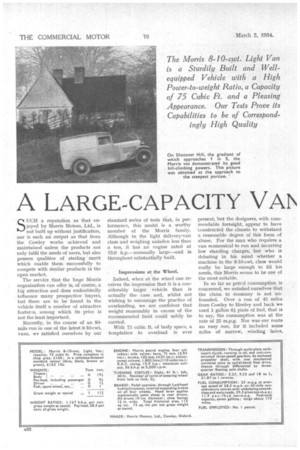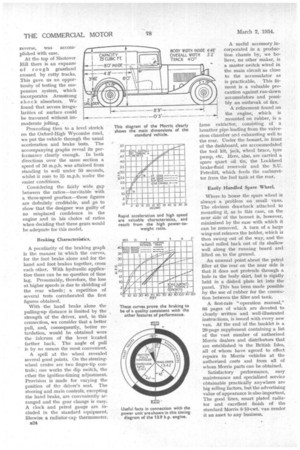A LARGE-CAPACITY VAN
Page 36

Page 37

Page 38

If you've noticed an error in this article please click here to report it so we can fix it.
with a FINE PERFORMANCE SUCH a reputation as that enjoyed by Morris Motors, Ltd., is not built up without justification, nor is such an output as that from the Cowley works achieved and maintained unless the products not only fulfil the needs of users, but also possess qualities of sterling merit which enable them successfully to compete with similar products in the open market.
The servke that the huge Morris organization can offer is, of course, a big attraction and does undoubtedly influence many prospective buyers, but there are to be found in the vehicle itself a number of attractive features, among which its price is not the least important.
Recently, in the course of an 80mile run in one of the latest 8-10-cwt. vans, we satisfied ourselves by our standard series of tests that, in performance, this model is a worthy member of the Morris family. Although in the light delivery-van class and weighing unladen less than a ton, it has an engine rated at 13.9 h.p.—unusually large—and is throughout substantially built.
Impressions at the Wheel.
Indeed, when at the wheel one receives the impression that it is a considerably larger vehicle than is actually the case and, whilst not wishing to encourage the practice of overloading, we are confident that weight reasonably in excess of the recommended limit could safely be carried.
With 75 cubic ft. of body space, a temptation to overload is ever
present, hut the designers, with commendable foresight, appear to have -constructed the chassis to withstand a reasonable degree of this form of abuse. For the man who requires a van economical to run and incurring low standing charges, but who is debating in his mind whether a machine in the 8-10-cwt. class would really be large enough to fill his needs, this Morris seems to be one of the most suitable.
In so far as petrol consumption is concerned, we satisfied ourselves that the claim to economy is not unfounded. Over a run of 45 miles from Cowley to Henley and back we used 1 gallon GI pints of fuel, that is to say, the consumption was at the rate of 25 m.p.g. Nor was our route an easy one, for it included some miles of narrow, winding lanes, several minor hills and the long climb, well known to users of the Oxford road, from the river at Henley up to Nettlebed in the Chilterns.
From the Morris works we took the Garsington road, turning off towards Warborough. Along these lanes we cruised at 30-35 m.p.h., taking the gradients in our stride at anything up to 40 m.p.h. Striking the main London road at Shillingford, we proceeded south-east, and then climbed steadily, passing the turning to Nuffield, from which Lord Nuffield (Sir William Morris) takes his title, on through Nettlebed and down into Henley's narrow, crowded streets, where we turned , by the famous bridge and retraced our tracks.
Hill-climbing Capabilities.
Approaching the hill at a good pace, we watched, with some interest, the speedometer needle as the slope stiffened. From 40 m.p.h. it dropped slowly, but maintained a position above 35 until the summit was nearly attained. There is little doubt that it Would have fallen hardly lower, but for the presence of another vehicle ahead of us which discretion forbade us to overtake.
We describe these details with the objeet of showing that no attempt was made to nurse the engine with a view to obtaining good, but possibly non representative, consumption figures. The vehicle was driven hard throughout the trial. Indeed, the fair speed at which the sharp turns and muddy surfaces on the -latter part of the return journey were negotiated, afforded a satisfactory test of the machine's stability and good cornering qualifies.
After our return to the works and the completion of the business of measuring the quantity of petrol consumed, we took the Morris to Shotover Hill. The steepest part of this acclivity is about 1 in 5 and its length is a bare three-quarters of a mile. On a non-stop climb first gear was needed for the steepest part, but as the slope became less severe a change up to " second " was successfully accomplished. Our minimum speed was 10 m.p.h., whilst, in the higher ratio, it quickly rose to 20 m.p.h., and the summit was actually breasted at 215 m.p.h. Nevertheless, immediately afterwards a thermometer recorded a coolingwater temperature of no more than 170 degrees F., despite the fact that the engine was new, the van having covered fewer than 100 miles.
While staging photographs, some rnanceuvring on the steep part of the hill was necessary, but no difficulty was experienced in manipulating clutch or hand brake under these conditions, which constituted a fairly severe test in view of the load on board. Indeed, starting from standstill up the hill, both forward and in
reverse, was accomplished With ease.
At the. top of Shotover Hill there is an expanse of rough grassland crossed by rutty tracks. This gave us an opportunity of testing the suspension system, which incorporates Armstrong shock absorbers. We found that severe irregularities of surface could be traversed without immoderate jolting.
Proceeding then to a level stretch on the Oxford-High Wycombe road, we put the vehicle through the usual acceleration and brake tests. The accompanying graphs reveal its performance clearly enough. In both directions over the same section a speed of 50 m.p.h. was attained from standing in well under 50 seconds, whilst it rose to 55 m.p.h. under the easier conditions.
Considering the fairly wide gap between the ratios—inevitable with a three-speed gearbox—these figures are definitely creditable, and go to show that the designer was guilty of no misplaced confidence in the engine and in his choice of ratios when deciding that three gears would be adequate for this model.
Braking Characteristics.
A peculiarity of the braking graph is the manner in which the curves, for the foot brake alone and for the hand and foot brakes together, cross each other. With hydraulic application there can be no question of time lag. Presumably, therefore, the loss at higher speeds is due to skidding of the rear wheels ; a repetition of several tests corroborated the first figures obtained.
With the hand brake alone the pulling-up distance is limited by the strength of the driver, and, in this connection, we consider that a better pull, and, consequently, better retardation, would be obtained were the fulcrum of the lever lccated farther back. The angle of pull is by no means the most convenient.
A spell at the wheel revealed several good points. On the steeringwheel centre are two finger-tip controls; one works the dip switch, the other the ignition-timing adjustment. Provision is made for varying the position of the driver's seat. The steering and main controls, excepting the hand brake, are conveniently arranged and the gear change is easy. A clock and petrol gauge are included in the standard equipment, likewise a radiator-cap thermometer.
n24 A useful accessory incorporated in a production chassis by, we believe, no other maker, is a master switch wired in the main circuit as close to the accumulator as is practicable. This fitment is a valuable precaution against run-down accumulators and possibly an outbreak of fire.
A refinement found on the engine, which is mounted on rubber, is a fume extfactor, consisting of a breather pipe leading from the valvestem chamber and exhausting well to the rear. Under the bonnet, in front of the dashboard, are accommodated the tool kit, jack, wheel brace, tyre pump, etc. Here, also, are carried a spare quart oil tin, the Lockheed brake-fluid reservoir and the S.U. Petrolift, which feeds the carburetter from the fuel tank at the rear.
Easily Handled Spare Wheel.
Where to house the spare wheel is always a problem on small vans. The obvious drawback attached to mounting it, as in this case, on the near side of the bonnet is, however, minimized by the ease with which it can be removed. A turn of a large wing-nut releases the holder, which is then swung out of the way, and the wheel rolled back out of its shallow well along the running board and lifted on to the ground.
An unusual point about the petrol filler at the rear on the near side is that it does not protrude through a hole in the body skirt, but is rigidly held in a dished plate let into the panel. This has been made possible by the use of rubber for the connection between the filler and tank.
A first-rate "operation manual," 86 pages of which are devoted to clearly written and well-illustrated instructions, is issued with every new van. At the end of the booklet is a 29-page supplement containing a list of the vast number of authorized Morris dealers and distributors that are established in the British Isles, all of whom have agreed to effect repairs to Morris vehicles at the authorized costs and from all of whom Morris parts can be obtained.
Satisfactory performance, easy maintenance and specialized service obtainable practically anywhere are big selling factors, but the advertising value of appearance is also important. The good lines, smart plated radiator and excellent finish of the standard Morris 8-10-cwt. van render it an asset to any business.




























































































